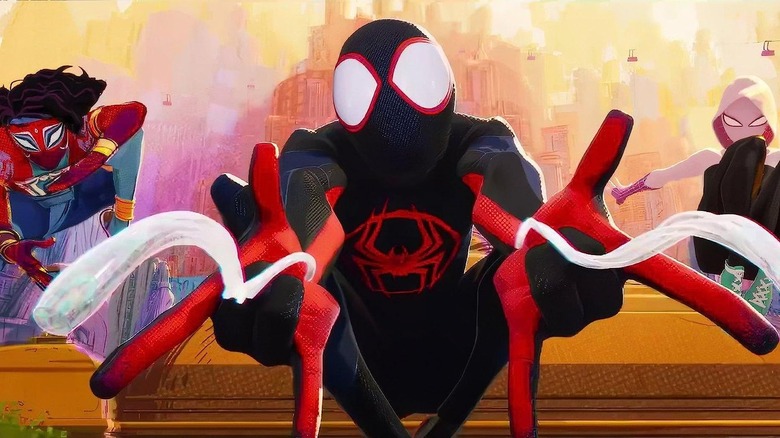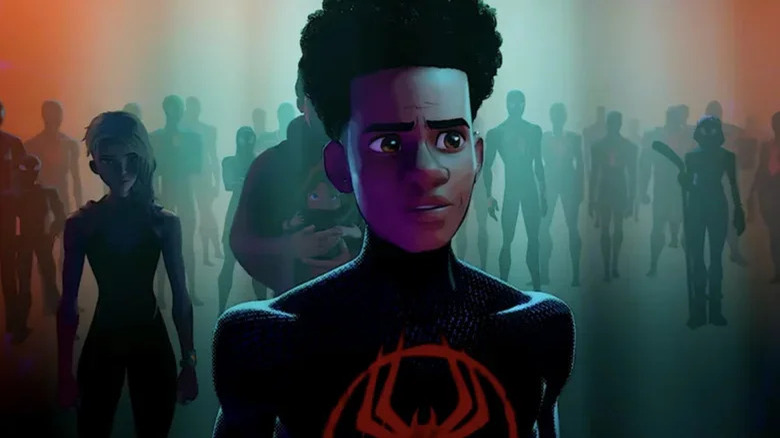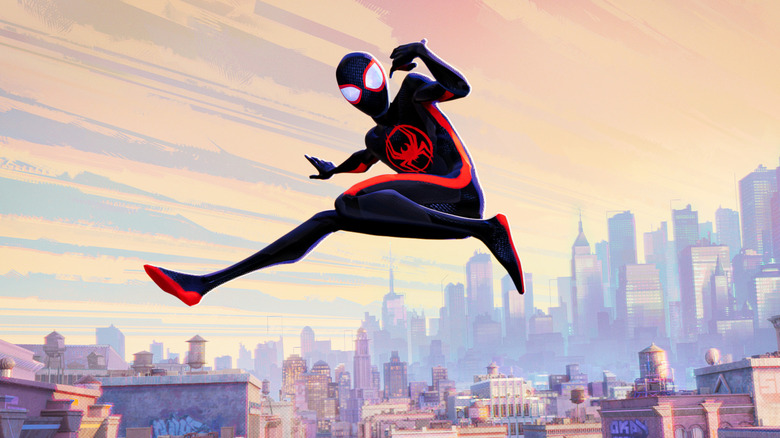Spider-Man: Across The Spider-Verse Composer Included Goose Honking In The Score
Somehow, "Spider-Man: Across The Spider-Verse" managed to outdo 2018's "Into The Spider-Verse" in pretty much every way. Sure, there are some that don't appreciate the cliffhanger ending (which actually totally works, by the way), but generally the film has been received as a triumph of both animation and filmmaking as a whole.
And so it should. There's so much that makes Sony's "Spider-Verse" sequel great, from the multiversal storyline that champions our ability to challenge established ideas and the notion of determinism to the rich tapestry of artistic styles that form the movie's dazzling aesthetic. In fact, the aesthetic is basically a plot element in its own right, telling the story of humanity's creative output from the Italian Renaissance to the modern day. But when you have a movie that's as visually accomplished as this, often the sound design can go overlooked.
That's a real shame. In both "Into the Spider-Verse" and "Across the Spider-Verse," the audio is equally as important as the visuals. Of course, it didn't help that the latter's release was plagued by audio mix issues, which producer Phil Lord quickly addressed before Sony issued newly-fixed prints. But the sequel literally starts with sound, with visualizations of Gwen Stacy (Hailee Steinfeld)'s drumming filling the screen. And that symbiotic relationship between sight and sound only gets more intricate and compelling as the movie continues, with individual characters and their various universes further informing the soundtrack. All of this is thanks to returning composer Daniel Pemberton, who also threw in some surprising audio elements that might have passed you by on first watch.
Beats and goose-scratch solos
Daniel Pemberton previously told Rolling Stone that Miles Morales' (Shameik Moore) world in "Across the Spider-Verse" was "very influenced by hip-hop culture" and had a "record scratching" element to it. But you might have missed just how integral those record scratches were to Miles' sound design.
Luckily, Pemberton has laid it all out for us. In an interview with the Motion Picture Association, he explained how deep he went with the scratching this time around, building on the approach he took to "Into the Spider-Verse." On the 2018 film, he used a technique whereby he would "record stuff, sort of put it on vinyl, so to speak, and then we scratched it in to make it feel more unconventional and more a part of Miles' world." For the sequel, Pemberton repeated this technique but took it to another "unbelievably time-consuming and exhausting" level, using the talents of the scratch DJ Blakey. This involved scratching every sound effect possible during the film's Miles reintroduction sequence, including "car crash noises, punches, pens, spray cans, and orchestral stabs."
When Miles first encounters The Spot (Jason Schwartzman) in "Across the Spider-Verse," they battle their way across Brooklyn, ending up in a car wash alongside a goose who unwittingly flies through one of The Spot's portals. Of course, Pemberton didn't waste the opportunity for some goose scratches:
"Remember a goose in the car wash? We got the sound of a goose, and then we scratched the sound of a goose, and it sounds really awesome. You can hear it in the film, but not as clearly as I'd like because there are a million other things going on. On the track 'My Name is Miles Morales,' the last third of that is pretty much beats and goose-scratch solos."
A mini hip-hop history
Daniel Pemberton's scratch-method is yet another example of how the "Spider-Verse" movies push things beyond the norm. Whereas the composer could have easily opted for some classic scratch sounds, like your standard "Ahhh" or "Fresh," he had the idea to apply the actual technique to the world around Miles itself. Which is, as most good ideas are, so simple yet so effective — and also just really, really cool.
But what's cooler is that the scratching provides a sense that Pemberton and the filmmakers generally have a reverence for the history of Miles' universe and Brooklyn itself as a piece of hip-hop history. The official soundtracks (as separate from Pemberton's score) to both "Into the Spider-Verse" and "Across the Spider-Verse" are populated by modern hip-hop stars like Metro Boomin and Swae Lee — hardly artists you'd associate with record scratching. But by using classic hip-hop tracks to introduce Miles, from Biggie's "Hypnotize" in the first movie to Rakim's "Guess Who's Back" in the second, you feel as though the filmmakers are also paying homage to Brooklyn's storied hip-hop history. Together, the classic tracks from hip-hop greats and Miles' more modern tastes combine to create this mini history of hip-hop culture, which is only heightened by Pemberton's score incorporating scratching as a central technique.
For those wanting to hear the goose scratch solo in all its glory, you can witness it in all its majesty here.


